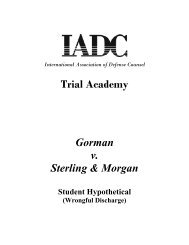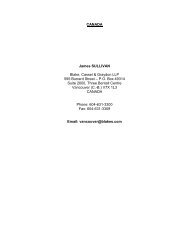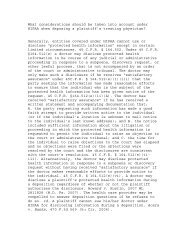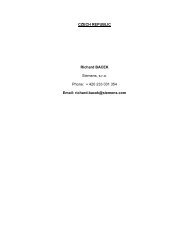Defense Counsel Journal - International Association of Defense ...
Defense Counsel Journal - International Association of Defense ...
Defense Counsel Journal - International Association of Defense ...
Create successful ePaper yourself
Turn your PDF publications into a flip-book with our unique Google optimized e-Paper software.
Page 472 DEFENSE COUNSEL JOURNAL–October 2012C. Defective Construction is an“Occurrence” but the BusinessRisk Exclusions ApplyThe next line along the spectrumconsists <strong>of</strong> those courts who have foundthat defective construction is an“occurrence” (or the courts who skippedthat analysis completely), but that thebusiness risk exclusions apply to barcoverage entirely. This viewpoint isillustrated by the decision <strong>of</strong> theMassachusetts Supreme Judicial Court inCommerce Insurance v. Betty CapletteBuilders. 16 In Betty Caplette, the insuredwas a general contractor who was suedbased upon defective septic systemsinstalled by subcontractors. The courtskipped the “occurrence” analysis andinstead interpreted the business riskexclusions. After referring to Weedo andquoting Dean Henderson, the court took anovel approach and held that the houseswere the insured’s “product” and theclaims were therefore excluded byexclusion (k) <strong>of</strong> the broad form generalliability policy. (The exclusion at issue inBetty Caplette was actually numbered (n),but it was the identical “your product”exclusion to exclusion (k) in the currentbroad form policy.)Since the court applied the “yourproduct” exclusion, the fact that the septicsystems were installed by subcontractorswas irrelevant. The court considered theinsured’s contention that the home wasmore properly characterized as “yourwork,” such that the subcontractorexception to the exclusion would apply.It rejected that argument, relying onprecedent which held that the entire house16 647 N.E.2d 1211 (Mass. 1995).is a builder’s “product.” 17 Many <strong>of</strong> thecases relied upon by the court have sincebeen superseded by opinions consideringthe post-1986 I.S.O. coverage form(although in only one was the result at alldifferent 18 ). The end result in these casesseems to be dictated more by policy thaninterpretation.Ironically, a builder who usessubcontractors in Massachusetts willenjoy the same coverage as the samebuilder in Nebraska despite the fact thatin Massachusetts defective construction isconsidered an “occurrence.” Obviously,different approaches to the same questioncan yield the same result. This approach,which was originally described by theMassachusetts Supreme Judicial Court asthe majority approach, is now theapproach <strong>of</strong> only a single court—Massachusetts.D. Defective Construction is an“Occurrence” and theBusiness Risk Exclusions DoNot ApplyFinally, at the most liberal end <strong>of</strong> thespectrum, we find decisions that havemade builders very happy, such as the17 See Gary L. Shaw Builders, Inc. v. StateAutomobile Mutual Ins. Co., 355 S.E.2d 130(Ga. 1987); Indiana Ins. Co. v. DeZutti, 408N.E.2d 1275 (Ind. 1980); Owings v. Gifford,697 P.2d 864 (Kan. 1985); Allen v. Lawton &Moore Builders, Inc., 535 So. 2d 779 (La. Ct.App. 1988); Gene & Harvey Builders, Inc. v.Pennsylvania Mf’r Ass’n Ins. Co., 517 A.2d910 (Pa. 1986).18 See Lee Builders, Inc. v. Farm BureauMutual Ins. Co., 137 P.3d 486 (Kan. 2006)(holding that defective construction was an“occurrence” but not considering the businessrisk exclusions).












